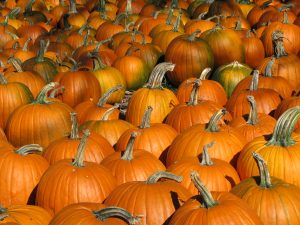It’s fall, and pumpkins of all kinds are being harvested and sold. You can find everything from small, knotty gourds to jack-o-lantern pumpkins for carving to record-breaking pumpkins too big to fit in your car. Purchasing pumpkins comes with an occasional disadvantage, like when they are ready long before you need them and when they cost more than your budget.
There is something you can do to avoid these pitfalls. You can learn how to grow a pumpkin patch in your backyard. Below are steps to follow to help your pumpkin patch be successful.
Measure the Planting Space
The size of your pumpkin patch is determined by the land you can cultivate. You can grow only a few pumpkins if you have one row in your garden. You may be overwhelmed with pumpkins if you plant an acre or multiple acres.
By measuring your planting space, you can estimate the number of seeds for the desired number of pumpkins. Mark the planting area and disc the ground so the soil is loose.
Buy the Right Seeds
Numerous pumpkin varieties exist today, each with a different purpose. Pie pumpkin varieties are smaller than other pumpkins and easy to grow. Jack-o-lantern pumpkins for carving can range from small to extra-large and have less meat on the inside. White pumpkins are great for painting, and gourds make decorating indoors and outdoors easy.
Purchase seeds that match the hardiness zone where you live. The USDA hardiness zone map typically recommends growing pumpkins in zones three through nine. The zone information, along with specific instructions regarding sunlight and watering, is on the seed package. Also, only purchase seeds from quality seed companies with excellent customer reviews.
Plant Your Seeds
Before scattering seeds in the ground, figure out your timeline. When do you want to harvest your pumpkins? After setting your desired harvest time, follow the instructions on the seed packets regarding growing time. Some pumpkins may take one to two months, while others may need three or four months to grow.
When you are ready to put the seeds in the ground, build a small mound of dirt first. Pumpkins need to be able to drain water after rain or watering. A small mound of dirt sets them up higher than other plants. You can place two or three seeds in each mound if there is plenty of room for the vines to spread out. As a rule, allow four to six inches between each mound of seeds.
Prevent Pests From Damaging Your Pumpkins
All plants attract insects and wildlife that want to feed on them. Groundhogs or woodchucks are one example of wildlife that will sneak into your pumpkin patch and taste-test the fruit, letting them rot after taking a bite. Squash bugs love pumpkin leaves because they contain sap. If you see spots on the pumpkin, it is likely due to squash bugs.
Depending on where you live, you may encounter cucumber beetles or melon worms, or aphids may be a problem. Squirrels, chipmunks, deer, mice, and raccoons enjoy eating pumpkin leaves and, if they can, will open a pumpkin to eat the meat and seeds inside.
Install fencing below the ground and over the plants to prevent nuisances like this. You may also want to place scarecrows nearby.
Water Your Plants
Pumpkin plants don’t like to sit in standing water, but they also don’t like to be too dry. The root system of a pumpkin plant is shallow, which means they can’t search for water deep in the ground, and they can dry out quicker, being closer to the top. Plan to water your pumpkins once or twice weekly, providing at least one inch of water.
Feed and Weed Your Plants
After a couple of weeks, you will see pumpkin plant leaves popping through the small mound of dirt. You will also see weeds popping through. With every watering, the weeds consume the water, too. Hand-picking weeds is the best method. Using tools like a shovel can damage the plant’s roots and vines.
When your pumpkin plants are about twelve inches tall, fertilize them with compost or a store-bought variety. Bigger fruits like pumpkins require more food than other fruits.
Harvesting Your Pumpkins
As your plants grow, a small green ball appears. It is the pumpkin. It will continue growing and changing color over the next few weeks or months. Your pumpkin is ripe and ready to pick when all of it is the color it should be, whether orange, white, green, or multi-colored.
The outside of the pumpkin, the rind, should be hard. The pumpkin is not ready if you can make an indentation on the rind with your fingernail or another object. Here are a few more ways to measure the ripeness of your pumpkins:
- The right amount of time has elapsed according to the instructions on the seed packet that tell you when a pumpkin is mature.
- The size and weight of the pumpkin match the description on the seed packet.
- The stem of a pumpkin is what takes nutrients from the vine and puts them into the pumpkin. The stem is hollow during this process. When the pumpkin matures, the stem wrinkles and becomes woody and hard since it no longer gathers nutrients.
- A tendril grows where the stem meets the vine. When growing, the tendril is green. When ripe, the tendrils are brown and dry.
When harvesting a pumpkin, keep the stem attached to the body. The stem is what helps your pumpkin last longer. When removed, an opening is exposed that speeds up the rotting process. To get the most life out of a pumpkin, let it sit in a dry space where it can get full sun for about two weeks. You should be able to enjoy them for several months.

